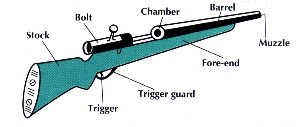 A
typical bolt-action long gun is shown here with the names
of some of its parts. Various types of long gun actions are shown
on the following pages of this brochure.
A
typical bolt-action long gun is shown here with the names
of some of its parts. Various types of long gun actions are shown
on the following pages of this brochure.Brought to you by Florida Firearms & Training & www.aaof.us
When handling, using, or storing any type of firearm, safety must be your first concern. Gun safety rules must be understood and applied in all situations involving firearms.
The three fundamental rules of gun safety must always be applied simultaneously when handling or using a gun:
The following gun safety rules should also be observed when using or storing a gun:
The National Rifle Association (NRA) provides a variety of courses in its Basic Firearm Training Program. These courses are conducted by NRA Certified Instructors and are available in the following subject areas: pistol, rifle, shotgun, home firearm safety, personal protection, and muzzleloading. Contact the NRA Training Department at (703) 267-1430 for a list of instructors in your area. For more information on firearm safety, contact: NRA's Education & Training Division at (703) 267-1500.
The two basic types of firearms are pistols (handguns) and long guns. The most common types of pistols in use today are revolvers and semi-automatics. The most common types of long guns are rifles and shotguns.
To understand how a firearm works, it is first necessary to understand the firearm's action. The action is a group of moving parts used to load, fire, and unload a gun. A gun is usually identified by its type of action. Various gun actions and unloading techniques are described in this brochure. When unloading a gun, always eject the cartridges into your hand or onto a soft, clean surface.
CAUTION: This brochure provides only general information about firearms. Due to the large variety of mechanical designs available, some guns will differ from the descriptions in this brochure. Some guns also require different handling and unloading techniques. For this reason, always be sure to get proper training from a competent instructor. Also read and understand the gun's instruction manual. If you have any questions or problems, consult a knowledgeable person.
 A
typical bolt-action long gun is shown here with the names
of some of its parts. Various types of long gun actions are shown
on the following pages of this brochure.
A
typical bolt-action long gun is shown here with the names
of some of its parts. Various types of long gun actions are shown
on the following pages of this brochure.
Some long guns use a magazine. A magazine is a storage device designed to hold cartridges ready for insertion into the firing chamber. The location of the magazine may vary depending upon the action, model, and make of the gun. Various types of magazines also exist. Two of these magazine types are described below.
 A box
magazine is usually found in the location shown here. Some
box magazines are detachable and can be removed by depressing a
button, latch, or similar release device. Other types of box
magazines are not detachable. Some have a hinged floorplate, and
are unloaded by pressing a release device that allows the
floorplate to open and the cartridges to drop out of the
magazine. Other types of non-detachable magazines do not have a
releasable floorplate, and the cartridges are usually ejected by
carefully opening and partially closing the action.
A box
magazine is usually found in the location shown here. Some
box magazines are detachable and can be removed by depressing a
button, latch, or similar release device. Other types of box
magazines are not detachable. Some have a hinged floorplate, and
are unloaded by pressing a release device that allows the
floorplate to open and the cartridges to drop out of the
magazine. Other types of non-detachable magazines do not have a
releasable floorplate, and the cartridges are usually ejected by
carefully opening and partially closing the action.
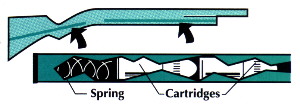 A tubular
magazine is usually found in one of the locations shown here.
Some tubular magazines have an inside tube which must be removed
in order to let cartridges drop out of the magazine. The action
must also be opened and partially closed several times in order
to be sure that no cartridges are left in the magazine. Other
types of tubular magazines do not have a removable inside tube,
and the cartridges are usually removed by carefully operating the
action of the gun. Because a cartridge can become stuck in a
magazine tube, the gun may still contain a cartridge after the
above steps have been taken. Therefore, leave the action open to
prevent a cartridge from being moved into the chamber.
A tubular
magazine is usually found in one of the locations shown here.
Some tubular magazines have an inside tube which must be removed
in order to let cartridges drop out of the magazine. The action
must also be opened and partially closed several times in order
to be sure that no cartridges are left in the magazine. Other
types of tubular magazines do not have a removable inside tube,
and the cartridges are usually removed by carefully operating the
action of the gun. Because a cartridge can become stuck in a
magazine tube, the gun may still contain a cartridge after the
above steps have been taken. Therefore, leave the action open to
prevent a cartridge from being moved into the chamber.
NOTE: Read the manufacturer's instructions for unloading your type of gun. However, whenever possible: (1) avoid handling the gun when a cartridge is in the chamber; and (2) avoid working the action in such a way that a cartridge is fully inserted into the chamber.
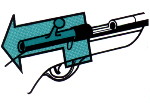 Bolt
actions are opened using a lift and pull motion similar to that
used to open a door bolt or gate bolt.
Bolt
actions are opened using a lift and pull motion similar to that
used to open a door bolt or gate bolt.
To Unload:
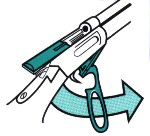 Lever
actions are opened by pulling the lever down and away from the
stock, and are closed by returning the lever to its original
position. Most lever-action guns have tubular magazines, but some
models may use box-type magazines.
Lever
actions are opened by pulling the lever down and away from the
stock, and are closed by returning the lever to its original
position. Most lever-action guns have tubular magazines, but some
models may use box-type magazines.
To Unload:
 Pump
actions are operated with a pumping motion. The action is opened
by pulling the fore-end of the gun to the rear, and closed by
pushing the fore-end back to its original position. Some
pump-action guns have tubular magazines, while other models use
box-type magazines.
Pump
actions are operated with a pumping motion. The action is opened
by pulling the fore-end of the gun to the rear, and closed by
pushing the fore-end back to its original position. Some
pump-action guns have tubular magazines, while other models use
box-type magazines.
To Unload:
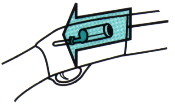 Semi-automatic actions are opened by pulling the bolt handle
straight to the rear. Some semi-automatics have tubular
magazines, while other models use box-type magazines.
Semi-automatic actions are opened by pulling the bolt handle
straight to the rear. Some semi-automatics have tubular
magazines, while other models use box-type magazines.
To Unload:
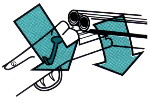 Hinge
actions are opened by moving a release lever to one side, and
then moving the hinged barrel(s) downward. Hinge-action guns do
not have magazines.
Hinge
actions are opened by moving a release lever to one side, and
then moving the hinged barrel(s) downward. Hinge-action guns do
not have magazines.
To Unload:
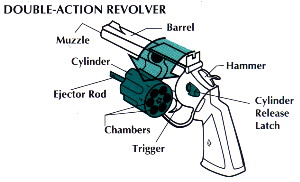 A
revolver is a pistol with a revolving cylinder that holds
cartridges in individual chambers. Each time the hammer moves to
the rear, the cylinder turns and brings a chamber in line with
the barrel and the firing pin. When the hammer falls, it causes
the firing pin to strike and fire the cartridge. In single-action
revolvers, the trigger performs only one action -- releasing the
hammer. The trigger does not cock the hammer. The hammer must be
cocked with the thumb, and will stay in a cocked position until
it is released by pulling the trigger. In a double-action
revolver, the trigger performs two tasks. When it is pulled, it
will cock and release the hammer. Most double-action
revolvers can also be fired in a single-action mode by manually
cocking the hammer with the thumb.
A
revolver is a pistol with a revolving cylinder that holds
cartridges in individual chambers. Each time the hammer moves to
the rear, the cylinder turns and brings a chamber in line with
the barrel and the firing pin. When the hammer falls, it causes
the firing pin to strike and fire the cartridge. In single-action
revolvers, the trigger performs only one action -- releasing the
hammer. The trigger does not cock the hammer. The hammer must be
cocked with the thumb, and will stay in a cocked position until
it is released by pulling the trigger. In a double-action
revolver, the trigger performs two tasks. When it is pulled, it
will cock and release the hammer. Most double-action
revolvers can also be fired in a single-action mode by manually
cocking the hammer with the thumb.
To Unload Single Actions:
To Unload Double Actions:
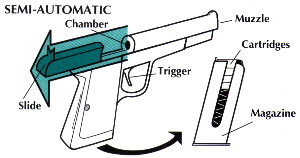 A
semi-automatic is a pistol that has only one chamber located at
the rear of the barrel. Cartridges are held in a storage device
called a magazine. When the pistol is fired, the slide moves to
the rear, ejects the empty case, and usually cocks the pistol. On
its return movement, the slide picks up a cartridge from the
magazine and pushes it into the chamber.
A
semi-automatic is a pistol that has only one chamber located at
the rear of the barrel. Cartridges are held in a storage device
called a magazine. When the pistol is fired, the slide moves to
the rear, ejects the empty case, and usually cocks the pistol. On
its return movement, the slide picks up a cartridge from the
magazine and pushes it into the chamber.
To Unload Semi-Automatics:
 A
muzzleloading gun is so named because it is loaded through the
muzzle. It does not use cartridges; instead, it is usually loaded
by pouring a measure of black powder into the barrel, and pushing
a cloth patch and lead ball into the barrel on top of the powder
charge. Muzzleloading firearms are available in long gun and
pistol models.
A
muzzleloading gun is so named because it is loaded through the
muzzle. It does not use cartridges; instead, it is usually loaded
by pouring a measure of black powder into the barrel, and pushing
a cloth patch and lead ball into the barrel on top of the powder
charge. Muzzleloading firearms are available in long gun and
pistol models.
Due to the construction of a muzzleloader, it is not easy to tell if it is loaded. Don't try to determine this yourself; instead, have a knowledgeable person make sure that the gun is unloaded.
 Hunter's
Code Of Ethics
Hunter's
Code Of Ethics 
Firearms Glossary
This brochure is not intended as a complete course in gun safety and is not a substitute for formal, qualified instruction in the handling, use, or storage of firearms.